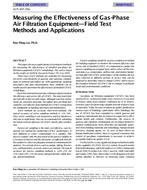This paper discusses applications of existing test methods for measuring the effectiveness of installed gas-phase air filtration equipment (GPAFE) in buildings. The work is based on the results of ASHRAE Research Project 791 (Liu 1995).
Three types of test methods are available for measuring low-level concentrations of gaseous and vaporous contaminants in ambient and indoor air. With appropriate sampling procedures and data interpretation, these methods can be readily used to determine the effectiveness of installed GPAFE in buildings.
Real-time instruments provide continuous data to monitor the efficiency and service life of GPAFE. The detection limits are typically in the low ppb range. Although real-time instruments are extremely desirable, the author does not think they would be cost-effective field methods for GPAFE testing from the standpoints of building operation and maintenance.
Active methods are accurate, short-term methods. The typical accuracy of active sampling methods is ±5%-10%. Since active sampling is not inexpensive and test duration is only one to eight hours, they are recommended for validating the initial removal efficiency of GPAFE shortly after installation.
Passive air sampling is the most cost-effective, easy-to-operate test method for monitoring GPAFE performance. It uses diffusion to collect contaminants in a sampler. This process requires only the placement of the passive sampler in a location of interest and the allowance of sufficient time for the sampler to collect an adequate amount of contaminants for analysis. No external devices such as pumps, tubing, flowmeters, calibration kits, or power sources are needed. The typical accuracy for passive sampling methods is ±20%-25% for VOCs and ±10%-15% for ozone, nitrogen dioxide, sulfur dioxide, and formaldehyde.
Passive sampling should be used as a routine test method for building engineers to monitor the removal efficiency and service life of installed GPAFE. It is important to conduct the passive sampling on a regular basis and to collect all the relevant data (e.g., temperature, airflow rate, and relative humidity) that affect the GPAFE performance. In this manner, the test data collected at different periods of service time can be analyzed to determine when to change GPAFE and to assess the irregular behavior of GPAFE due to changes in pollutant loads and environmental conditions.
Units: SI
Citation: ASHRAE Transactions, 1998, Vol. 104, Part 2, Toronto, ON
Product Details
- Published:
- 1998
- Number of Pages:
- 11
- File Size:
- 1 file , 120 KB
- Product Code(s):
- D-7643
